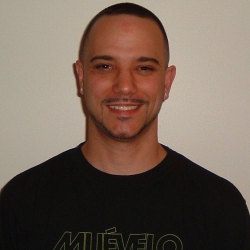
Joseph Barranco
( He/Him/His )PhD Astrophysics, University of California, Berkeley, 2004.
B.A. Physics, Astronomy and Astrophysics, Harvard University, 1993.
At SF State since 2007.
Note: While Prof. Barranco is Department Chair, he is not available to supervise any new research students.
Note: While Prof. Barranco is Department Chair, he is not available to supervise any new research students.
My field of research is computational astrophysical & geophysical fluid dynamics; that is, I study the motion of fluids on the scale of planets, stars, and interstellar clouds. Such flows tend to be highly chaotic and turbulent, and so practical solutions of the equations of motion (e.g. the Navier-Stokes equations) require supercomputer simulations. Here at SFSU, we have a small cluster called SF-STAR (Supercomputer Facility for Space & Terrestrial Advanced Research). I also have allocations through NSF's XSEDE (eXtreme Science & Engineering Design Environment), specifically at the San Diego Supercomputer Center (SDSC).
My primary research collaborator is Prof. Philip Marcus at the Berkeley Computational Fluid Dynamics Laboratory, U.C. Berkeley College of Engineering.
My collaborators and I have discovered a new hydrodynamic instability that occurs in stratified, rotating shear flow. We nicknamed it the "Zombie Vortex Instability" because it occurs in the magnetically "dead zones" of protoplanetary disks, the disks of gas and dust in orbit around newly formed protostars. It is out of these disks that planets form, somehow growing from micron-sized dust into massive planets in only 10 million years (that's really short on cosmological timescales!). Another reason we called it the Zombie Vortex Instability is that once one "zombie" vortex is created, it triggers (or infects!) a neighboring region of the flow to go unstable to produce another "zombie" vortex, which then goes on to infect other regions, producing a cascade of "zombie" vortices, which ultimately makes the "dead zones" of protoplanetary disks no longer dead, but "undead!"
- Barranco, J.A., Pei, S., Marcus, P.S., 2018, “Zombie Vortex Instability. III. Persistence with Nonuniform Stratification and Radiative Damping.” The Astrophysical Journal, 869. arXiv:1810.06588.
- Marcus, P.S., Pei, S., Jiang, C.H., Barranco, J.A., 2016, “Zombie Vortex Instability. II. Thresholds to Trigger Instability and the Properties of Zombie Turbulence in the Dead Zones of Protoplanetary Disks.” The Astrophysical Journal, 833:148–161. arXiv:1605.07635.
- Marcus, P.S., Pei, S., Jiang, C.H., Barranco, J.A., Hassanzadeh, P., Lecoanet, D., 2015, “Zombie Vortex Instability. I. A Purely Hydrodynamic Instability to Resurrect the Dead Zones of Protoplanetary Disks.” The Astrophysical Journal, 808:87–102. arXiv:1410.8143.
- Penev, K., Barranco, J.A., Sasselov, D.D. 2011, “Three-dimensional Spectral Simulations of Anelastic Turbulent Convection.” The Astrophysical Journal, 734:118. arXiv:0810.5151.
- Lee, A.T., Chiang, E., Asay-Davis, X., Barranco, J.A., 2010, “Forming Planetesimals by Gravitational Instability: II. How Dust Settles to its Marginally Stable State.” The Astrophysical Journal, 725: 1938–1954. arXiv:1010.0250.
- Lee, A.T., Chiang, E., Asay-Davis, X., Barranco, J.A., 2010, “Forming Planetesimals by Gravitational Instability: I. The Role of the Richardson Number in Triggering the Kelvin-Helmholtz Instability.” The Astrophysical Journal, 718: 1367–1377. arXiv:1010.0248.
- Penev, K., Barranco, J.A., Sasselov, D.D. 2009, “Direct Calculation of the Turbulent Dissipation Efficiency in Anelastic Convection.” The Astrophysical Journal, 705: 285–297. arXiv:0810.5370.
- Barranco, J.A. 2009, “Three-Dimensional Simulations of Kelvin-Helmholtz Instability in Settled Dust Layers in Protoplanetary Disks.” The Astrophysical Journal, 691: 907–921. arXiv:0711.4410.
- Hartman, J. D., Gaudi, B. S., Holman, M. J., McLeod, B. A., Stanek, K. Z., Barranco, J. A., Pinsonneault, M. H., Meibom, S., Kalirai, J. S., 2009, “Deep MMT Transit Survey of the Open Cluster M37. IV. Limit on the Fraction of Stars With Planets as Small as 0.3 RJ .” The Astrophysical Journal, 695:336–356. arXiv:0809.3807.
- Hartman, J.D., Gaudi, B.S., Pinsonneault, M.H., Stanek, K.Z., Holman, M.J., McLeod, B.A., Meibom, S., Barranco, J.A., Kalirai, J.S., 2009, “Deep MMT Transit Survey of the Open Cluster M37. III. Stellar Rotation at 550 Myr.” The Astrophysical Journal, 691: 342–364. arXiv:0803.1488.
- Hartman, J.D., Gaudi, B.S., Holman, M.J., McLeod, B.A., Stanek, K.Z., Barranco, J.A., Pinsonneault, M.H., Kalirai, J.S., 2008, “Deep MMT Transit Survey of the Open Cluster M37. II. Variable Stars.” The Astrophysical Journal, 675: 1254–1277. arXiv:0709.3484.
- Hartman, J.D., Gaudi, B.S., Holman, M.J., McLeod, B.A., Stanek, K.Z., Barranco, J.A., Pinsonneault, M.H., Meibom, S., Kalirai, J.S., 2008, “Deep MMT Transit Survey of the Open Cluster M37. I. Observations and Cluster Parameters.” The Astrophysical Journal, 675: 1233-1254. arXiv:0709.3063.
- Barranco, J.A. & Marcus, P.S. 2006 “A 3D Spectral Anelastic Hydrodynamic Code for Shearing, Stratified Flows,” Journal of Computational Physics, 219:21–46. arXiv:astro-ph/0509063
- Barranco, J.A. & Marcus, P.S. 2005, “Three-Dimensional Vortices in Stratified Protoplanetary Disks,” The Astrophysical Journal, 623:1157-1170. arXiv:astro-ph/0501267
- Barranco, J.A., 2004, "Theory and Numerical Simulation of Three-Dimensional Vortices in Protoplanetary Disks", Ph.D. Thesis, University of California, Berkeley
- Barranco, J.A., Marcus, P.S., & Umurhan, O.M. 2000, “Scalings and Asymptotics of Coherent Vortices in Protoplanetary Disks,” in Studying Turbulence Using Numerical Simulation Databases – VIII, Proceedings of the 2000 Summer Program, Stanford University/NASA–Ames Center for Turbulence Research, p.85–95.
- Barranco, J.A. & Marcus, P.S. 2000, “Vortices in Protoplanetary Disks and the Formation of Planetesimals,” in Studying Turbulence Using Numerical Simulation Databases – VIII, Proceedings of the 2000 Summer Program, Stanford University/NASA–Ames Center for Turbulence Research, p.97–108.
- Barranco, J.A. & Goodman, A.A. 1998, “Coherent Dense Cores. I. NH3 Observations,” The Astrophysical Journal, 504:207-222.
- Goodman, A.A., Barranco, J.A., Wilner, D.J., & Heyer, M.H. 1998, “Coherence in Dense Cores. II. The Transition to Coherence,” The Astrophysical Journal, 504:223-246.
- Barranco, J.A. 1993, "Velocity Coherent Structure in the Dense Cores of Dark Molecular Clouds", B.A. Thesis, Harvard University
Adobe Acrobat Reader is required to view PDF files. This is a free program available from the Adobe web
site. Follow the download directions on the Adobe web site to get your copy of Adobe Acrobat Reader.